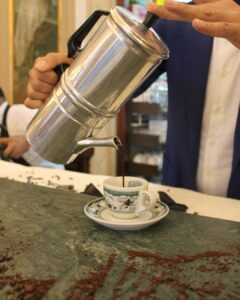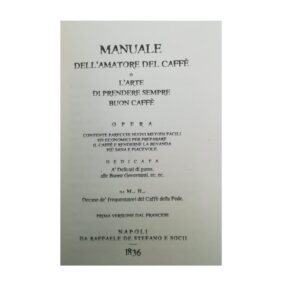Caffè, giornalismo e grandi donne: L’ultimo desiderio per una condannata a morte? Una tazza di caffè!w2

Articolo di Michele Sergio pubblicato su L’Espresso napoletano del mese di marzo 2018
A Napoli, lungo Salita di Sant’Anna di Palazzo, vi è una targa commemorativa di Eleonora Pimentel de Fonseca, posta, dove abitava, nel 1999 in occasione del duecentesimo anniversario dalla sua morte.
La de Fonseca fu tra gli artefici della Repubblica Napoletana del 1799, effimera (gennaio-giugno 1799) ma importante parentesi democratica durante il regime borbonico.
Di famiglia portoghese, nata a Roma, poco dopo la nascita i genitori la trassero con loro a Napoli dove si trasferirono. Forte di una cultura classica, letterata e autrice di poemi e componimenti, divenne bibliotecaria della regina Maria Carolina, con la quale frequentava i salotti degli illuministi napoletani, in un primo tempo sostenuti dalla stessa sovrana, poi, in seguito da ella invisi e contrastati. Forte fu il legame tra le due donne, ma si interruppe drasticamente con il sopraggiungere, dalla Francia, delle notizie che facevano conoscere i drammatici sviluppi della Rivoluzione ed in particolare della morte della sorella Maria Antonietta. Parallelamente la de Fonseca aveva abbracciato gli ideali libertari e democratici e fu tra i protagonisti dei moti che condussero all’istituzione della Repubblica, di cui divenne vera e propria anima dalle colonne del periodico settimanale il Monitore Napoletano, da lei diretto. Restaurata la monarchia, fu giustiziata a 47 anni insieme ad altri repubblicani.
A questa straordinaria donna lo scrittore Enzo Striano ha dedicato il premiatissimo romanzo, “Il resto di niente” del 1986 da cui è stato tratto l’omonimo film diretto nel 2004 dalla regista Antonietta De Lillo.
La de Fonseca aveva la passione per il caffè. Si racconta che da bambina osservava con curiosità le caffettiere napoletane utilizzate dalla mamma e dalla zia, che seguiva affascinata nelle operazioni di preparazione della bevanda.
Crescendo il caffè divenne il pretesto (accanto ai biscotti, cioccolata e tabacco) per intrattenere i suoi ospiti in casa e stringere amicizie, quello stesso caffè intorno al quale si radunavano gli illuministi napoletani nei loro salotti.
Durante i mesi della rivoluzione napoletana il caffè accompagnava quotidianamente il febbrile lavoro nella redazione de Il monitore. Si narra che in fase di realizzazione del primo numero del giornale, la pausa caffè fosse l’unico momento in cui Donna Lionora riusciva a tranquillizzarsi, a stemperare i dubbi e i timori sull’impatto che, il giornale e le idee attraverso esso diffuse, avrebbero avuto sul popolo napoletano. Anche le riunioni con i compatrioti si svolgevano sempre davanti alle tazza bollenti di caffè, vero catalizzatore di socialità, idee, pensieri.
Il caffè accompagnerà la de Fonseca addirittura nel drammatico giorno della sua morte. Pima d’essere giustiziata incontrò il prete al quale espresse un solo ultimo desiderio: bere una tazza di caffè. Emblematico episodio che conferma come il napoletano accompagna ogni momento della vita con un caffè, finanche l’ultimo!




